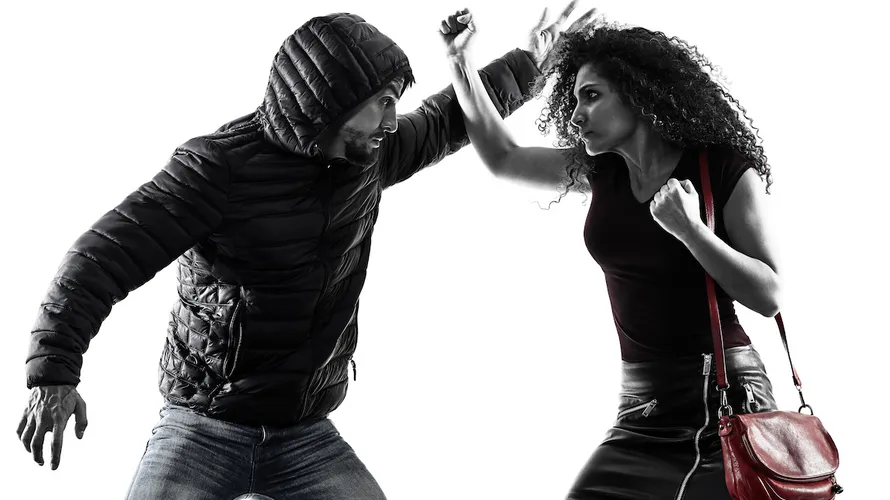September 08 | 2022

Even as a child, before I studied martial arts, the subject of self-defense would often come up. Granted, it was the late 70s and early 80s, so things were a little different. (Heck, some of us were still eye-balling that book of secrets by Count Dante in the back of our comic books.) However, when people would talk about self-defense it inevitably boiled down to a litany of things in two categories: You should never
do this, or you should always do that.
The “this” or “that” could be some seemingly innocuous thing that had the potential to result in disastrous consequences. For example, I remember a friend of the family saying, “Never stand with your back knee locked out. Otherwise, if you are attacked and someone kicks your knee, it can bust out the back of your leg.” (gulp) Good to know, even if I was seven. I suspect the advice came from a relatively unique experience that they had or heard about, but it was just one of many “nuggets” of self-defense that was posited in my brain and has stayed there over the decades.
After I was a victim of violent crime, I became quite a bit more interested in self-defense and wanted to learn how to protect myself with real knowledge beyond some anecdotal asides and odd advice. Interestingly, after I started studying, I learned rather quickly that every other style, except whatever I was studying at the moment, was “real self-defense,” at least that is what everyone said. For this reason, I would like to stay from which style is best and focus on some universal principles that apply to everyone.
Self-Defense
A self-defense encounter is different than a fight. I regard a self-defense situation as being a life-threatening experience that cannot be avoided. Whereas, a fight may sometimes be a preventable altercation, and as such, should be treated differently. In fact, self-defense confrontations can be very different. The experience that brought me into martial arts involved three attackers with a knife. A tough situation for anyone, regardless of what martial art they study. Add to that the nature of surprise, and speed, and you have a very arduous confrontation.
I’ve heard people say that they will do this, because the attacker will do that, and I usually like to question them: how do you know that that’s what the attacker will do? While it may be tempting to teach and learn with such absolutes, they have no application in the real world. Ultimately, you don’t know what someone may do and I think it is dangerous to assume so.
As a rule, I think it is important to keep self-defense training rooted in fundamentals with applications to a variety of circumstances. It is better to have one or two techniques that you can apply to hundreds of situations than a bunch of specific techniques. Keep your training real.
Always
Below, I’ve taken the always and never categories and included ideas that I believe are useful. (For one thing, you can stand any way you want.)
- Always accept the random nature of self-defense situations and don’t assume you know what will happen or when.
- Always train in a martial art that you are confident will supply the proper tools to survive a self-defense incident. (And what a resource you have here at Black Belt.)
- Always seek to have the proper mental attitude regarding self-defense. Seek a calm mind, and an even temper, and avoid situations that put you at risk.
- Always train with the assumption that life is not like a movie. While self-defense techniques may work great in the school, when applied in real life, they are messy, and some may not work. May not work? Yes, and so you have to train your mind to move on from plan A to plan B, C, D, etc.
Never
What are the don’ts? What should you never do? Here are some things that I think should be avoided.
- Never put faith in a weapon. Weapons can be taken from you, or for some reason be unavailable (can’t get to it) or even fail (doesn’t work on the attacker as intended). A weapon shouldn’t be the only tool you have. Train yourself. Depend on you.
- Never underestimate your opponent. This one is timeless and yet bears repeating.
- Never assume there is just one attacker.
- Never forget that survival means surviving. That could mean getting away as much as vanquishing your assailant. If you can get away, do that.
- Never stop training your mind and body. Learning a few techniques from a one-day or even a weekend course is no substitute for a deeper level of training over time. The acquired skills and intangible benefits gained from training for a long period exist beyond self-defense and are great for personal development and peace of mind.
In the context of a physical attack, there are so many variables that it is impossible to list them all and prepare. That means that a much more concept-oriented approach will work best. Many martial arts are very good for self-defense, but like a gladiator in the arena, they are essentially just the weapon you choose, and ultimately you are the warrior.
![]()